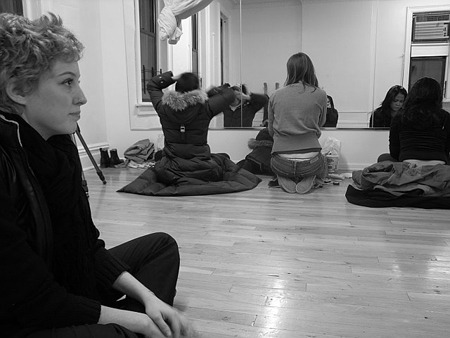The Business of Art: Esther Neff on ‘The Glorybowl Trilogy’
Esther Neff (left) with performers Chiasui Chen, Chelsea O’Connor, and Tess Jamias rehearsing at the Brooklyn Arts Exchange (2008).
The Transformational Grammar of the Institutional Glorybowl is a performance trilogy using live performance, video, clay animation, music, and sound to examine the relationships individuals have with the institutions that form their lives.
My research on said relationships between individuals and institutions, in order to turn them into performance material, exists in many forms. For all three pieces I have included interviews with individuals, texts from the fields of sociology, cognitive psychology, political science, complex systems theory, etc, and findings from movement research done through experimentation with performers. It’s important, I feel, to place no hierarchy between forms of research, and allow the re-behaving of physical actions (i.e. sitting at a desk in a classroom and noting emotions felt) the same authority as the writings of academics.
Almost immediately after beginning my research on the trilogy (Schooled and Unschooled), I noticed that in fields addressing institutional forms and their genealogies a perceived dichotomy exists between emotional and sophist “grammars.” This dichotomy is seen as a divide between “informational” perceptions, of the kind formed in the political and social sciences, by philosophy, cognitive psychology, and systems/complexity theories, and “emotional” experiences, or perceptions found through associative rationale, subjective memory, and relativity frameworks. I found this particularly fascinating, and one of my primary goals with this trilogy is to create something that exists on both sides of this informational/emotional dichotomy and speaks to the flaws in associating institutions with thought and private structures with emotion, which traditionally minimizes the latter in favor of the former. My theory is that this perceived dichotomy can be bridged in performance through the emoting of thoughts and the intellectualization of emotions on a concrete level.
Very simply, this means that the performers and I need to find detailed emotional reactions and interactions with that which are often relegated to a “dry,” informational sphere. Performer Herbie Go in Workforce/Forced Work, for example, was given text (loosely citing Emile Durkheim) about the socially acceptable sequence of career events, studies in a particular field, interviewing for a job, and being given the job. Eventually, Go was able to connect the text to personal emotions, imbuing the text with the feeling of frustration in memorizing facts in school, of nervousness in an interview, and of relief and resignation in getting a new 9-5 job. In addition, in performance, Go slowly closed the heavy metal door of an old safe (in the abandoned vault on Wall Street that is occupied by the resident artists of the Lower Manhattan Cultural Council), alluding to the sealing of his fate, the mimetic platitude “one door closes and another opens,” or even the sealing of a tomb.
Likewise, “emotional” perceptions can be removed from conceptions of subjectivity and unreliability by placing them into “informational” structures such as statistics, charts, equations, and instructions. This can also be purely entertaining, a kind of positivist absurdism.
In rehearsal, we work to make it clear that often the characters themselves are confused about what is a systemically mandated, institutionalized behavior, and what is an emotional response. Ian Dunn’s “Bad Kid” character in Schooled and Unschooled became a kind of allegory for this confusion, with statements such as the following delivered in a manner saturated with social desperation and shame:
In my mind sometimes I see a tree. The trunk is the crux of the issue or the thing I need information about. But sprouting out of the trunk are a large number of limbs some of which are as wide as the trunk itself. Sprouting out of these limbs are branches and then more branches and then twigs…and I can’t follow them all. They are infinite and gorgeous. Leaves of every color and fruits…strange things hang off some of the branches glowing orbs and juicy lung-shaped things. Some things are alive and make grunts and little squeals. It’s raining money and food and genitalia.
Self-judgment and internalized, automatic self-discipline (Foucault) often rises to the surface in explorations of social and institutional authority and the most interesting question for me becomes, what forms do concrete influences on social behavior take, and how are shared rules for behavior developed, disseminated, and digested? Sociologist Alain Badiou’s theory that these conceptions seem to exist in the blood, and are practically unspeakable in their fundamentality seems useful to me. In discussing this idea, I often use Badiou’s term for these nerve-like bundles of influences: doxa.
Two years ago when this trilogy began with Schooled and Unschooled, I was exploring my own isolation from certain strains of doxa. Having been homeschooled K-12 made the idea of school a foreign and somewhat terrifying concept to me, not a familiar, shared (doxa-forming) experience. From an inability to place my experiences in time (with no grade, schedule, teacher’s name to link them to), through the lack of the physical experience of needing to raise my hand to speak, I found the concept ofdoxa a very pertinent basket into which I could put the implications of all of these differences. My research, especially the interviews, were undertaken with honest curiosity and a desire to use myself as a guinea pig to discover which documentary techniques communicated private/emotional experience most effectively in live performance. What I gained from this, in terms of practice, and what I further applied to Workforce/Forced Work, is a way of thinking about the horizons of individuals based in the concept of doxa and the possibility of revealing patterns in conceptions of self rather than simply representing selves onstage.
In Schooled and Unschooled there is a sequence in which the performers illustrate a model of memory using repetitive movement, chairs, and rubber balls. During this, one performer breaks loose, leaving her place in the sequence and causing the rubber balls (representing knowledge as material matter) to be thrown haphazardly towards the audience rather than safely into her hands. Leaving her place in the memory model causes guilt and anxiety, which can be seen in her posture and heard in her voice as she declares her opposition and use of the memory model itself and how it encourages people to conceive of learning and knowledge. As she speaks, her emotional reactions to the doxic influences causing the guilt and anxiety build up, eventually forcing her to return to the action.
This kind of forced participation in institutional systems as strongly encouraged by doxic influences to the extent that an individual feels uncomfortable, anxious, even fatally threatened by any deviance can be contrasted with the more commonly considered kind of authority (as a boss to an employee for example). This contrast creates a dramatic tension in the trilogy, especially in the scene fragments, where employees are sexually harassed by their bosses and pupils are categorized and labeled by their teachers at the same time that both individuals (teacher and pupil alike) feel pressurized by internal authoritative frameworks to behave in certain ways. Yet both the basic human relationship and the internalized, automatic kinds of authority, and the gray areas between them, both in terms of enacting such relationships in performance and, I believe, in the real world, are largely about Distribution of the Sensible. While doxa are unspeakably deeply rooted beliefs, values, and morals, that which is “Sensible” is defined as “fact,” “knowledge,” or “science” and is perceived as a beneficial step toward a perceived functional system. Distribution of this definition, or the placement of the label “Sensible” on something, is a task given to those individuals and groups with social power and authority, and assigned to the parts of the self internally which have been most consistently rewarded in social context.
In art, especially in performance, when doxa and the Sensible are contrasted or otherwise juxtaposed, individuals (no matter how much authority they have) can be placed in a position of intense engagement and re-evaluation that may allow them to examine the laws, systems of authority, and publicly condoned morality that dictate places for and forms of participation in the act of Distributing of the Sensible that are available to individuals and, in addition, establish separate or more specific modes of perception for themselves.
In order to explore as many of these modes as possible, in Workforce/Forced Work for example, I take care to place a concept or idea in the “center” of the space, on one side placing information in the form of text, spoken or projected as a PowerPoint presentation, and on the other side placing gestural movements taken from the action of filling a coffee cup at Starbucks or painting the side of a house for example, and dense music/sound compositions made from recordings in workplaces (by composer Brian McCorkle) such as the turbines from powerplants, the metal on metal of slaughterhouses, and the murmur and clack of offices, which are highly subjective and perceived as “emotional.” This structure catalyzes dramatic tension between a concept (institution) and ways of perceiving/understanding it (informational vs. emotional). Furthermore, it places subject (concept, idea) in the primary relationship with the viewer/audience member, which produces many, if not all, possible formal relationships existent between these. For Schooled and Unschooled, this was facilitated structurally by making the piece a class lead by a real teacher, and inWorkforce/Forced Work, making the structure a seminar with the first half aimed at “employees” and in the second half at “management.”
For Institute_Institute, the last piece in the trilogy, which is currently in development, no single institution (school, work) will be used. Rather, the piece will explore the formation of institutions and the concept “institution” itself, as well as doxa and Distribution of the Sensible described here. Our seeds for this final installment combines the above concepts with the question as to how we may “give the individual [audience member and participant in the project] direct access to the invisible universe of Sensibility” (Barthes). Through this focus, I hope that the form of the piece will become structurally aligned with the concepts it examines. Perhaps the piece will be entirely comprised of surveys taken by the live audience.
Although the three works have moved, hopefully, beyond formal experimentation into the creative realm of expression and the uncanny, my practice has been extremely affected through wrestling with an approach to performance that unifies an argument for the work itself. What I mean by this is that Distribution of the Sensible, as well as the expression of the inexplicable doxa, are inherently a creative voice’s claim, the claim of anyone who makes work for an audience or viewer, which is in turn a model for how individuals (artists and non-artists) can participate in formation of their society (in the tradition of Novalis, Beuys, and various self-help manuals). Finally The Transformational Grammar of the Institutional Glorybowl is an experiment toward finding a way of actualizing performance’s role as an emotional and intellectual bridge between grammars, which is a socio-political role no matter which concepts lie at the core of the work.
Esther Neffwas born on a sustainable organic farm in Indiana and homeschooled K-12. She has studied at the Royal Shakespeare Company, directed for the late Arthur Miller, and shown work at chashama, through the LMCC, at the Brooklyn Arts Exchange, the Brecht Forum, Dixon Place, the West End Theatre, Gathering of the Tribes Gallery, University of the Streets, Manhattan Theatre Source, University Settlement, and ABC No Rio, amongst other venues in New York City and Brooklyn, the New World Arts Center in Indiana and the 555 Gallery in Detroit, and in parks, plazas, parking lots, and other public spaces nationwide and in Munich, Germany. She holds a BFA from the University of Michigan and is the founder of the performance co-op PPL (www.panoplylab.org) of which she is co-Artistic Director with Brian McCorkle, as well as a member of the live/work collective Surreal Estate in East Williamsburg.





